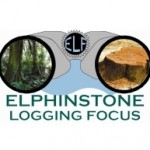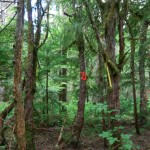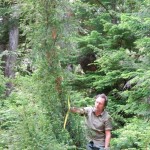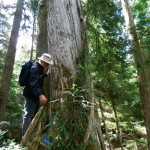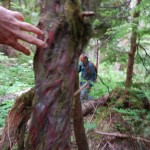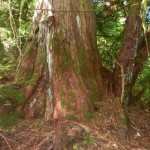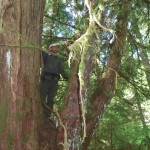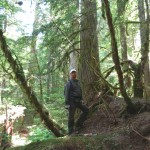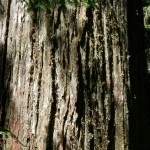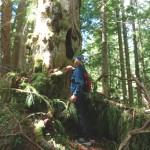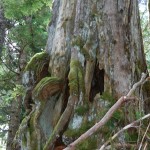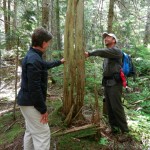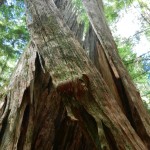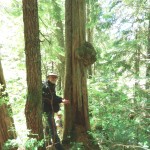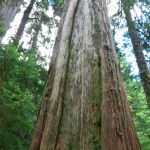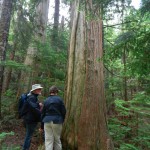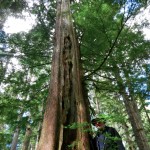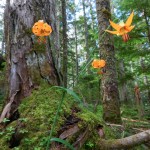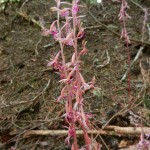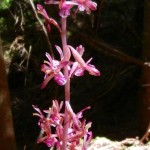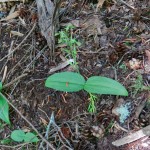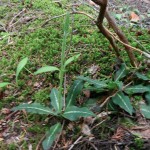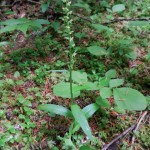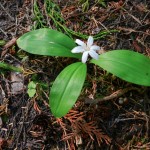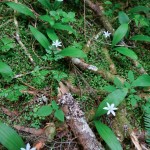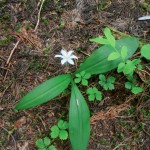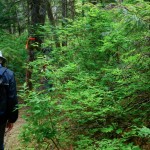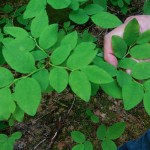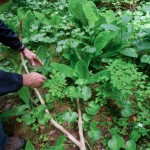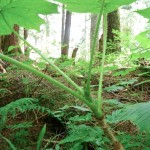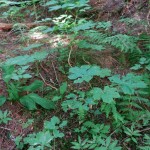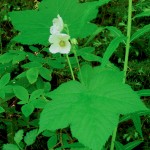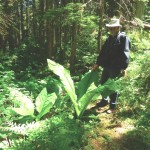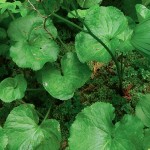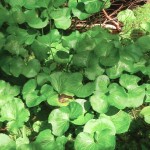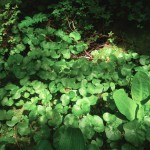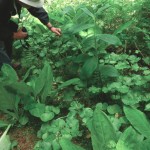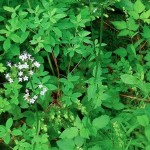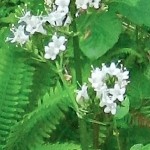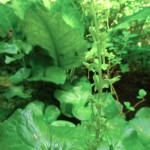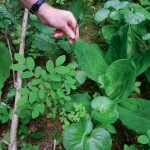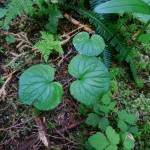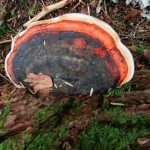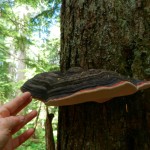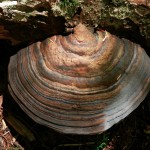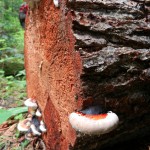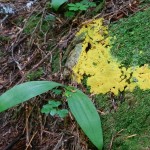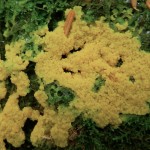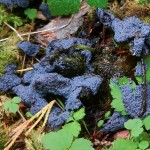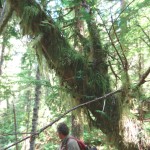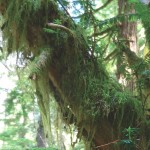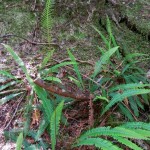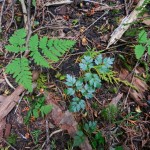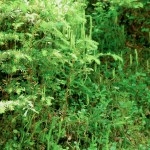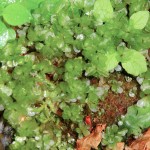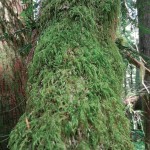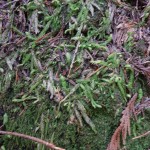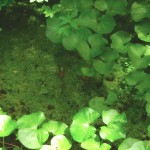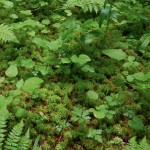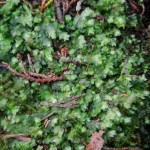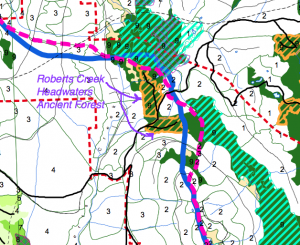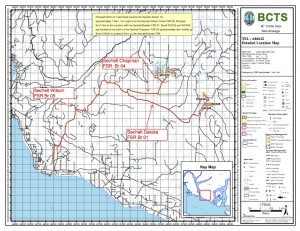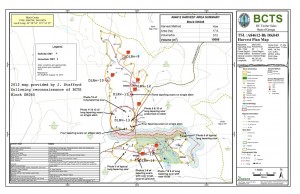
News/Reports
The Roberts Creek Headwaters Ancient Forest
On July 11 2013, Ross Muirhead, Bill Legg and Hans Penner of Elphinstone Logging Focus, an environmental group based in Roberts Creek on the Sunshine Coast, took Helen and I up to up to a small patch of forest presently included in a BC Timber Sales Block (BCTS) Cutblock DK045. They had identified this area with concern for it’s preservation because of a number of factors, not the least of which is an unusual density of Pacific Western Yew (Taxus brevifolia) which are growing in close association with Old Growth Yellow Cedar, (Cupressus nootkatensis)
Be sure to click on the images below to be able to appreciate the full impact of them.
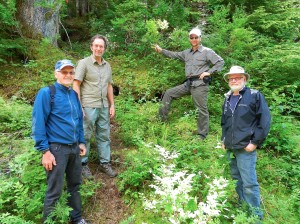 Ross Muirhead writes: “We call the forest ‘The Roberts Creek Headwaters Ancient Forest”. This Yellow-Cedar forest contains up to 350 Pacific Yew trees. We had a group of 5 volunteers conduct a tree survey of the Yews today, flagging and numbering each Yew. The area is a small BC Timber Sales block of about 3 football fields in size. I’ve spoken to the Forest Planner in charge and he has sent a message to an Ecologist within the Ministry of Environment to see if they think this forest warrants becoming an Ecological Reserve. “
Ross Muirhead writes: “We call the forest ‘The Roberts Creek Headwaters Ancient Forest”. This Yellow-Cedar forest contains up to 350 Pacific Yew trees. We had a group of 5 volunteers conduct a tree survey of the Yews today, flagging and numbering each Yew. The area is a small BC Timber Sales block of about 3 football fields in size. I’ve spoken to the Forest Planner in charge and he has sent a message to an Ecologist within the Ministry of Environment to see if they think this forest warrants becoming an Ecological Reserve. “
Over a rough logging road with several waterboard trenches, a few miles above Robert’s Creek on the flank of Elphinstone Mountain, we navigated to the start of the trail into the forest. Immediately they pointed out that the sign they had erected at the trail-head had been destroyed since they were last there.
On entering the forest, the immediate impression was of a shaded spongy moss covered area. The predominant trees rising from the forest floor were giant Old-growth Yellow Cedars. What makes the area unique was that around the base of most of the cedars, a fringe of two to four Pacific Western Yews rose up as if from a cup at the base of the cedars. In the photo Hans touches two yews from the base of one of the cedars.
- Orange markers show the path and yellow markers are placed on every yew
- Ross tags another Pacific Western Yew
- By the roadside one yew had escaped notice previously so Ross adds a tag.
- The yellow ribbon marks another yew added to the large inventory
- Yews wrapping around the trunk of a Yellow Cedar
- The knobby bark of a very old Pacific Western yew tree
- Ross at the base of a Yew and Cedar
- A yellow ribbon tagged Pacific western yew
- Two yew trunks coming from the base of one cedar
- The typical growth pattern with Yews growing outwards from the base of the Yellow Cedar
- Deeply grooved bark of an Old Growth Yellow Cedar
- Character engrained in the bark
- An old cedar on an even older nurse log, probably dating back over 1000 years..
- I check out a very old and gnarled Cedar.
- Helen and Bill examine a fragile trunk skeleton
- Skeleton of a trunk. There have been no fires to remove old skeleton cedars.
- Hans and a large burl on a cedar
- Helen and Hans examine a CMT
- Cedar bark was stripped from this tree on two occasions.
- Culturally modified tree .
Early on the trail, the special atmosphere of the woods was noticeable by the wild flowers. A patch of Columbia Lilies, Lilium columbianum emerged close to the path.
- Lilium columbianum , Columbia Tiger Lily
- Corallorhiza mertensiana -Pacific coralroot
Other orchid species were also abundant:
- Listera caurina – Northwestern Twayblade On the dry forest floor.
- possibly Plantathera spp.
- Goodyera oblongifoia- rattlesnake plantain on the dry forest floor,
- Platanthera stricta- slender rein orchid in the wet bog area.
Many Queen’s Cup were scattered with other plants on the forest floor.
- Clintonia uniflora- queens cup
- Chimaphila menziesii-Menzies pipsissewa
SHRUBS:
Several one to two metre shrubs grew scattered throughout the area with the high bush blueberry being predominant.
- Menziesia ferruginea –False Azaelia
- Blueberry
- Vaccinium ovalifolium, Oval-leafed Blueberry
- Wetland vegetation
- Oplopanax horridus–Devil’s Club
- Devil’s Club
- Rubus parviflorus , thimbleberry
PLANTS OF THE WET STREAM SIDE AREA:
- Lysichiton americanum- skunk cabbage with deer Cabbage.
- Lysichiton americanum- Skunk Cabbage
- Fauria crista galli- Deer cabbage
- Fauria crista galli-deercabbage
- Veratrum viride- Indian Hellebore, a very poisonous plant if consumed
- Cicuta douglasii- Douglas water hemlock
- Cicuta douglasii-Douglas-water hemlock: Also very poisonous
- Cicuta douglasii- Douglas-water-hemlock leaves
- A Rein Orchid in the wettest areas.
- Blueberries and Skunk cabbage
- Wetland vegetation
- Viola palustris- marsh violet ?
FUNGUS , SLIME MOLDS AND LICHENS:
Fungus were represented by several species:
- Fomitopsis pincola
- Bracket fungus –Fomitopsis pinicola
- Bracket Fungus
- Close up of Bracket Fungus
- Young Fomitopsis pinicola
- young Fomitopsis pinicola on cut log
- Boletus spp. ( maybe mirabilis)
- Boletus spp.
- Slime Mold, possibly Fuligo septica
- Slime Mold, possibly Fuligo septica
- Purple slime mold , possibly Lindbladia tubulina
- Beard Lichen on a Pacific Western Yew trunk
- Close up of Beard Lichen, Usnea longissima and other epiphytes
FERNS AND CLUB MOSSES:
- Blechnum spicant- deer fern
- Dryopteris expansa- spiny wood fern
- Spiny wood fern and Coptis asplenifolia, Fern-leaved goldthread which is not a fern.
- Lycopodium clavatum- Running club moss
- Lycopodium clavatum- running club moss
BRYOPHYTES:
On the trail back to the roadway, I paused briefly to take a few samples of mosses and liverworts from a two square meter the area around the stream bed. I brought these samples back to Metchosin where Kem Luther identified them as the following:
Rhizomnium glabrescens: Fan moss, the one with the large leaves .
Kindbergia oregana: Oregon beaked moss with feather-like fronds.
Dicranum fuscescens: Broom moss, a frond mixed in with the Kindbergia
Dichodontium pellucidum : Wet rock moss, a small moss with straight, dark green stems/leaves.
Plagiochila porelloides: Cedar-shake liverwort, a large liverwort.
Cephalozia sp. The two-horned pincerwort: A small liverwort mixed in with the sphagnum.
Isothecium stoloniferum:
Plagiothecium/Buckiella undulatus:
Sphagnum spp. Sphagnum moss (possibly pacificum) Covers much of the area near the stream bed
- Rhizomnium glabrescens: Fan moss
- Yew trunk covered with moss, probably Isothecium stoloniferum
- Plagiothecium/Buckella undulatus (upper half of picture) on a yew trunk.
- Sphagnum spp. under the Deer Cabbage
- Spahgnum spp.
- Possibly the liverwort, Plagiochila porelloides:

